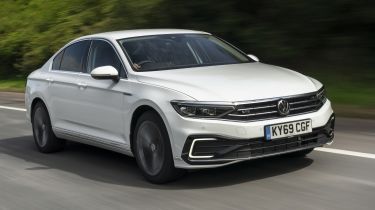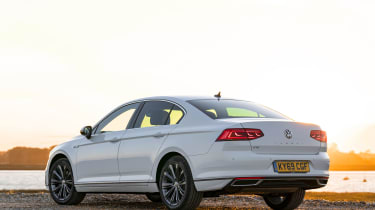Volkswagen Passat GTE review
The VW Passat GTE saloon is an excellent plug-in hybrid, but it's neither the most practical nor the best value choice on the market

Pros
- Good electric range
- Spacious interior
- Nice to drive
Cons
- Estate is more practical
- Sometimes-slow gearbox
- Economy when battery drained
| Car type | Electric range | Fuel economy | CO2 emissions |
|---|---|---|---|
| Plug-in hybrid | 36-37 miles | 217-235mpg | 28-30g/km |
Available in saloon and estate form, this latest generation of the Volkswagen Passat GTE plug-in hybrid is the best yet. The Passat GTE is still a strong rival to other plug-in hybrids like the BMW 330e, Skoda Superb iV, Mercedes C-Class, and Peugeot 508.
Under the bonnet of the Passat GTE, there's a 1.4-litre turbocharged petrol engine that works in conjunction with an electric motor to produce a total power output of 215bhp. That's enough for a 0-62mph time of 7.2 seconds (a few tenths quicker than the estate model) and a top speed of 138mph.
Like all plug-in hybrids, the Passat GTE offers a highly impressive official fuel-economy figure (235mpg), but that assumes you're always leaving home with a full battery and making maximum use of the car's posted 37-mile electric range.
The weather, temperature and specific driving routes can all affect these numbers, and once the battery's charge has been depleted, you're likely to see fuel economy in the region of 40mpg in the course of normal driving.
CO2 emissions stand at 28g/km for the entry-level GTE and 30g/km for the more fully featured GTE Advance; in either case, that combines with the car's official electric range to put it in the 10% band for Benefit-in-Kind company-car tax during the 2020-21 financial year.
Charging the Passat's 13kWh battery takes about three and a half hours, and because charging speed is limited by the car's on-board charger, you won't top up any faster than that, even if you plug into a public rapid charging point. So it's best to get a wallbox charger installed at your home or office and let the car charge slowly while you sleep or work.
The Passat’s signature traits of comfort, smoothness and quietness are here (and doubly so when running in pure-electric mode), along with plenty of space for both front and rear-seat passengers. The GTE is no match for a BMW 330e when it comes to driving enjoyment and driver engagement, however.
The saloon isn’t as practical as the Estate, but standard kit is the same across the two models. There's a choice of GTE and GTE Advance trim levels, with the former getting LED lights, alloy wheels, an eight-inch touchscreen, DAB digital radio, satellite navigation, smartphone connectivity, leather seat trim and blue ambient interior lighting as standard.
The range-topping GTE Advance increases the alloy-wheel size from 17 to 18 inches and the touchscreen from eight to 9.2 inches, as well as adding LED matrix headlights, voice control, keyless entry and a powered tailgate.
Overall, the saloon version of the Passat GTE is an impressive package. But the Estate model offers more carrying capacity, while there are also hatchback and estate versions of the closely related Skoda Superb iV to consider; they offer essentially the same technology for a lower list price.
For a more detailed look at the Volkswagen Passat GTE, read on for the rest of our in-depth review...
